An Arizona politician left behind a legacy of photographs.
In an election year, it’s hard to see politicians as people interested in anything other than getting your vote. But they do have other dimensions. Take the late five-term Arizona senator Barry Goldwater, who lost a White House bid to Lyndon B. Johnson in 1964 in the biggest presidential landslide since 1820. Whatever you think about his political legacy of conservatism, Goldwater had an impressive creative legacy. When he died in 1998, he left a collection of more than 15,000 photographs — he called it his “last will and testament to my love for my native state.” Some of the best images are of Native Americans. “I photographed every tribe, and they’re damn good people. I like them,” Goldwater was quoted in a remembrance in The Arizona Republic.
He received his first camera in 1934 from his wife, Peggy, who also bought him a part interest in the now-defunct Rainbow Lodge and Navajo Trading Post in north-central Arizona. Goldwater put the camera to constant use. He traveled — piloting his own plane and hiking — to remote portions of the Navajo and Hopi reservations, taking pictures, making friends, and often delivering desperately needed supplies.
Along the way, he became acquainted with photography giant Ansel Adams. “Many years ago — many moons, as the Indians would have said — I was at the head of the Rainbow Bridge trail, southwest of Navajo Mountain,” Adams recounted in the foreword to one of five books of Goldwater’s images. “There I met a young man who was obviously pursuing photography, as I was and with obvious fervor. He introduced himself as Barry Goldwater of Phoenix.”
Goldwater showed his work at countless lectures around the state. His photographic stumping would eventually provide a steppingstone into politics, but photography (along with ham radio and collecting katsinam) would remain his passion. “Barry photographed not as an outsider, but as somebody who was part of the state of Arizona, who was part of the West, who knew the role of and the importance of Native Americans and who knew their real social setting, their real social problems, and didn’t try to hide any of that,” former director of Tucson’s Center for Creative Photography Terence Pitts told The Arizona Republic shortly after Goldwater’s death. “He photographed Native Americans with great dignity, but also with great realism.”
Assessing his body of work, Ansel Adams commented, “He saw the region — historic sites and relics and people — in terms of images. ... [H]e made photographs of historical and interpretive significance, and for this we should be truly grateful.” Goldwater himself was characteristically straightforward about it: “I wanted people to know what Arizona looked like.”
Homeland: Photographs by Barry Goldwater is on view July 10 – September 25 at Huntsville Museum of Art in Huntsville, Alabama.
From the July 2016 issue.












